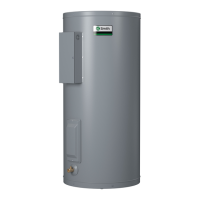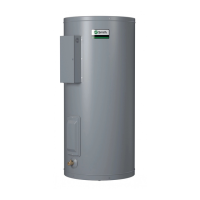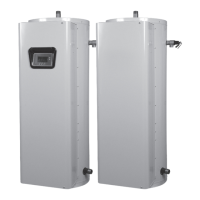Commercial Electric Water Heater Use and Care Guide • 5
If there is a parcular risk of scalding
(for example, the elderly, children, or
people with disabilies) or if there
is a local/provincial law requiring a
certain water temperature at the hot
water tap, then these precauons are
parcularly important.
According to a naonal standard
American Society of Sanary Engineering
(ASSE 1070) and most local plumbing
codes, the water heater’s thermostat
should not be used as the sole means to
regulate water temperature and avoid
scalds.
Properly adjusted Thermostac Mixing
Valves installed, allow you to set the
tank temperature to a higher seng
without increasing risk of scalds. A
higher temperature seng allows the
tank to provide much more hot water
and can help provide proper water
temperatures for appliances such as
dishwashers and washing machines.
Higher tank temperatures (140°F, 60°C)
also kill bacteria that cause a condion
known as “smelly water” and can
reduce the levels of bacteria that cause
water-borne diseases.
Do not use chemicals that could
contaminate the potable water supply.
Do not use piping that has been
treated with chromates, boiler seal, or
other chemicals.
To reduce the risk of a
re that could destroy
property and seriously
injure or kill people:
• Do not store things that can burn
easily such as paper or clothes next to
the water heater.
• Be sure the juncon box cover and
the access door covers are in place.
These covers keep debris from
entering and potenally being ignited,
and help keep any internal res from
spreading.
• Keep the water heater from becoming
wet. Immediately shut the water
heater o and have it inspected by a
qualied person if you nd that the
wiring, thermostat(s) or surrounding
insulaon have been exposed
to water in any way (leaks from
plumbing or leaks from the water
heater itself can damage property
and could cause a re risk). If the
water heater is subjected to ood
condions or the thermostat(s) have
been submerged in water, the enre
water heater must be replaced.
• Make electrical connecons properly,
according to the instrucons on page
18. Use 10 gauge solid copper wire.
Use a UL listed or CSA approved strain
relief. Connect ground wire to green
ground screw.
High temperatures and
pressures in the water
heater tank can cause an
explosion resulng in property damage,
serious injury or death. A new
Temperature and Pressure (T&P) Relief
Valve is included with your water heater
to reduce risk of explosion by
discharging hot water. Addional
temperature and pressure protecve
equipment may be required by local
codes.
A naonally recognized tesng
laboratory maintains periodic
inspecon of the valve producon
process and ceres that it meets the
requirements for Relief Valves for Hot
Water Supply Systems, ANSI Z21.22/
CSA 4.4. The T&P Relief Valve’s relief
pressure must not exceed the working
pressure rang of the water heater as
stated on the rang plate.
Maintain the T&P Relief Valve properly.
Follow the maintenance instrucons
provided by the manufacturer of the
T&P Relief Valve (label aached to T&P
Relief Valve) and the procedure that
starts on page 27.
An explosion could occur if the T&P
Relief Valve or discharge pipe is
blocked. Do not cap or plug the T&P
Relief Valve or discharge pipe.

